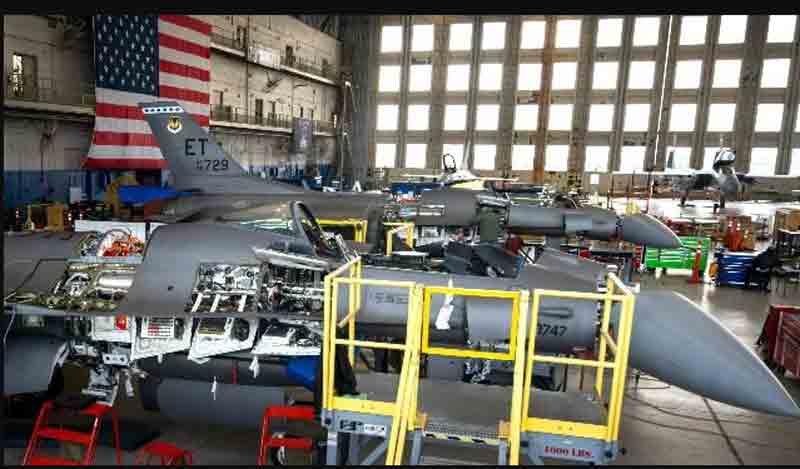At Eglin Air Force Base in Florida, a pioneering experiment is taking place that has the potential to redefine aerial warfare. On April 1, 2025, the sixth and final F-16 Fighting Falcon arrived at the base, completing the fleet designated for the Viper Experimentation and Next-gen Operations Model – Autonomy Flying Testbed program, known as VENOM-AFT.
This initiative, spearheaded by the U.S. Air Force, seeks to enhance these legendary fighter jets with artificial intelligence, ushering in a new era of combat aviation linked to the ambitious Collaborative Combat Aircraft initiative. Social media posts have generated considerable excitement about this development, emphasizing the arrival of these AI-equipped F-16s and their capacity to revolutionize military operations in the air.
However, beneath the initial excitement lies a more profound inquiry: Are these modified F-16s simply experimental platforms for advanced technology, or do they represent a significant transformation in America’s approach to aerial combat?
The concept of autonomous flight is not entirely new, although the means to realize it have only recently become viable. Decades ago, during World War II, the U.S. military explored the idea of unmanned aircraft through Operation Aphrodite, an ambitious yet flawed attempt to convert B-17 bombers into radio-controlled flying bombs.
The technology of the 1940s was insufficient to fulfill this vision, leading to the project’s decline. Fast forward to 2017, when the Air Force revisited the idea with Have Raider II, a lesser-known experiment that enabled an F-16 to fly autonomously for the first time, albeit in a limited scope. These early efforts laid the foundation for the current developments at Eglin, where VENOM-AFT distinguishes itself by incorporating modern AI and advanced sensors into a reliable combat platform.
To grasp the current developments surrounding the F-16s, it is essential to examine the aircraft and the modifications it is undergoing. The F-16 Fighting Falcon, initially launched by General Dynamics (now Lockheed Martin) in 1978, is a single-engine multirole fighter celebrated for its agility and adaptability.
Capable of exceeding speeds of Mach 2 and boasting a combat radius of over 340 miles with external fuel tanks, the F-16 has been a cornerstone of the U.S. Air Force for more than forty years, participating in various conflicts from the Gulf War to operations in Afghanistan. Its fly-by-wire flight control system, a groundbreaking innovation at its introduction, positions it well for autonomy enhancements, as it already utilizes computer-assisted precision.
As part of the VENOM-AFT program, these aircraft are being equipped with a suite of advanced technologies, including active electronically scanned array (AESA) radars such as the APG-83, which offer enhanced target detection and tracking capabilities compared to older mechanically scanned systems. Additionally, electronic warfare systems are being integrated, improving the aircraft’s capacity to autonomously identify and counteract enemy threats.
The artificial intelligence being trialed in these F-16s builds upon earlier initiatives like the Air Force Research Laboratory’s Skyborg program, which created aircraft-agnostic autonomy software, and DARPA’s Air Combat Evolution (ACE) project, which investigated AI-driven dogfighting strategies.
While the specific details of the algorithms are confidential, Air Force officials indicate that they are engineered to manage intricate combat situations—encompassing beyond-visual-range confrontations and close-quarters maneuvers that challenge the jet’s 9G capabilities. Unlike human pilots, who may experience blackouts under such extreme conditions, AI could theoretically perform these maneuvers without pause, opening up fascinating possibilities regarding the limits of aerial warfare.
However, safety is of utmost importance. During testing, pilots will remain in the cockpit to oversee the AI’s actions and are prepared to step in if necessary. Lt. Col. Joe Gagnon of the 85th Test and Evaluation Squadron describes this as a “human-on-the-loop” strategy, ensuring that the aircraft are never operating independently, thus combining human judgment with machine accuracy as the technology evolves.
The VENOM-AFT program is not merely an experiment with a few F-16s; it serves as a precursor to a much larger initiative—the Collaborative Combat Aircraft [CCA] program. The Air Force plans to deploy a fleet of at least 1,000 unmanned drones, referred to as “loyal wingmen,” which would accompany manned fighters like the F-35 Lightning II and the upcoming Next-Generation Air Dominance [NGAD] platform.
These CCAs, significantly less expensive than the $78 million F-35, could perform various roles such as carrying munitions, disrupting enemy radar, or conducting reconnaissance in contested airspace, thereby enhancing the operational range and safety of human pilots. The six F-16s stationed at Eglin are being utilized as test subjects in this extensive experiment, aimed at demonstrating that autonomous software can effectively navigate the complexities of combat.
As reported by Air & Space Forces Magazine, the program has conducted “countless aircraft combat scenarios” in simulations since 2024, evaluating everything from one-on-one dogfights to two-on-one confrontations, both within and beyond visual range. Maj. Trent McMullen, a test official with the 40th Flight Test Squadron, highlighted that these simulations enable the AI to hone its strategies through thousands of iterations, a feat that no human pilot could achieve.
The implications extend well beyond the CCA program itself. Data collected from VENOM could contribute to NGAD, a classified “family of systems” focused on a sixth-generation fighter anticipated to launch in the 2030s. Unlike conventional fighters, NGAD may not always require a pilot, instead depending on a network of autonomous drones to achieve dominance on the battlefield.
There are discussions about leveraging these insights for ground-based systems, such as robotic vehicles or missile defense systems, indicating a significant military transition towards AI-driven warfare. Meanwhile, America’s adversaries are not remaining idle. China’s FH-97A, a stealthy loyal wingman drone introduced in 2021, indicates that Beijing is striving to match or surpass U.S. capabilities in this area.
Russia is also advancing with its S-70 Okhotnik, a heavy unmanned combat aerial vehicle designed to operate alongside Su-57 fighters. Although neither has publicly showcased the level of AI integration seen in VENOM, their development highlights the global stakes involved in this technological advancement, positioning the Eglin tests as a potential counterbalance in an intensifying arms race.
Despite the advanced technology, the human factor remains a vital component of this equation. Pilots from the 40th Flight Test Squadron and the 85th Test and Evaluation Squadron, both located at Eglin, are central to the VENOM trials.
These pilots are not just any aviators; they are experienced testers who are used to pushing aircraft to their limits. Picture yourself in a cockpit, observing an AI take control of a jet you have manually flown for years. Lt. Col. Robert Waller, commander of the 40th, shared with Popular Science in 2023 that the pilot’s responsibilities are twofold: ensuring the aircraft returns safely and assessing the AI’s performance.
There exists a peculiar duality—part caregiver, part evaluator—illustrating the challenging shift from human oversight to machine control. Some individuals may experience a sense of obsolescence, aware that their expertise could eventually be rendered unnecessary, while others view this as an opportunity to influence the future of their profession. Regardless, their insights will enhance the AI, increasing its intelligence with every operation.
This collaboration between humans and machines also brings forth ethical dilemmas that cast a shadow over the initiative. To what extent should an AI be entrusted with decision-making in combat scenarios? Even with a pilot involved, the rapid pace of contemporary warfare—where instantaneous decisions can determine survival—might encourage commanders to rely more heavily on automation.
The Air Force maintains that safety and oversight are paramount, with Gagnon asserting that “there will never be a time when the VENOM aircraft will operate entirely ‘on its own’ without human involvement.”
However, as technology progresses, that distinction may become less clear. The X-62A VISTA, another AI-enhanced F-16 tested at Edwards Air Force Base, successfully completed 12 autonomous missions in 2022, including simulated dogfights, according to a report from The Aviationist. Should VENOM’s F-16s follow a similar path, the Air Force may soon confront a critical question: when does “human-on-the-loop” transition to “human-out-of-the-loop”?
Historically, the F-16 has consistently demonstrated its value. During Operation Desert Storm in 1991, F-16s conducted over 13,000 sorties, delivering precision-guided munitions and engaging Iraqi MiG fighters with exceptional effectiveness. In the Balkans and Iraq, they adapted to various roles—neutralizing air defenses, targeting ground installations, and even tracking down Scud missiles.
At Eglin, the F-16 is set to undergo another transformation, not through new weaponry or engines, but by integrating advanced digital technology. While aircraft like Russia’s MiG-29 and China’s J-10 rely on brute force and sophisticated avionics, respectively, the VENOM-enhanced F-16s are designed to outsmart them, responding more swiftly than any human pilot could manage.
The future of the VENOM program is both exciting and unpredictable. The Air Force aims to have the first fully modified F-16 ready for ground testing by October 2025, a goal supported by strong collaboration between Eglin’s developmental and operational test teams. With a budget request of $17 million for 2025 and plans for consistent funding through 2029, as reported by Defense News, this initiative is a top priority.
Achieving success could lead to retrofitting older F-16s into cost-effective drones, enhancing a diminishing fleet as F-15s are phased out and F-35 production slows. It may also pave the way for a new operational doctrine, where pilots manage swarms of AI-controlled wingmen, maneuvering them like chess pieces across the sky. Maj. Ross Elder, the developmental test lead for VENOM, described it as “a pivotal chapter in the advancement of aerial combat capabilities” in comments to Air & Space Forces Magazine, a view supported by promising simulation results.
As the sixth F-16 lands at Eglin, the larger implications become clearer. This initiative is not merely about six aircraft; it represents a significant military investment in a future where machines take center stage. The combination of AI with a proven platform like the F-16 could transform air dominance, rendering current dogfights almost outdated. However, despite the enthusiasm, some uncertainty lingers.
Will the Air Force and the general public have confidence in an AI to conduct warfare? Can it effectively combine technological advancement with the human insight that has been pivotal in securing victories for decades? These six F-16s could provide insights, or they may just represent the initial phase of a path that lacks a definitive conclusion. Regardless, the skies over Florida are currently the setting for the evolution of American air power, unfolding through each autonomous flight.
Discover more from Defence Talks | Defense News Hub, Military Updates, Security Insights
Subscribe to get the latest posts sent to your email.





